Human Settlement: Early Peoples of the Mojave Desert
Recently, Mojave Desert
petroglyphs
(rock pictures) have played an important role in debates about the age of the
first human occupation of the New World. New dating results show that Paleoindians may have reached this area as
long as 15,500 years ago. No associated habitation sites have yet been discovered in the Mojave, however, which
suggests that these prehistoric peoples moved from place to place. Over time human settlement patterns became
increasingly organized, with more complex rituals and a subsistence reliant on seeds,
plants,
and farming.
Small-game hunting contributed meat protein to the peoples’ diet.
Several tribal groups have lived in the Mojave Desert within the past 2,000 years. The northern and eastern
portions, for example, were occupied by the
Kawaiisu,
Kitanemuk,
Serrano, and
Koso,
and Southern Paiute bands,
including the
Chemehuevi.
Culturally distinct, these groups nevertheless spoke related languages and had similar
socioeconomic systems. Resource gathering was done in family groups over wide areas, but for at least part of
each year life centered on more permanent villages. The tribes knew much about Mojave Desert resources,
enabling them to gather supplies from all portions of their territories. They generally had friendly relationships
with neighboring groups such as the
Mohave,
though they also experienced episodes of intertribal hostility.
The
Mohave Indians
made pottery from
clay
and crushed
sandstone,
decorating their creations with geometric
designs. The art of tattooing was also important to the Mohave, who frequently adorned their faces 500 km
trips to the Pacific Coast to trade pottery and other goods for seashells and beads. Mohave legend holds
that tribal runners could cover the distance in only a few days, traveling by way of perennial
springs
and the
Mojave River.
The Chemehuevi tribe spoke a different language from that of the Mohave Indians. They occupied a particularly
barren portion of the Mojave Desert and wrested a rough living from the open land. Like their Mojave neighbors,
the Chemehuevi were highly mobile, making use of resources throughout their large territory; however, they also
had settlements to which they returned regularly. To transport goods and for other purposes, they created complex,
beautiful baskets from reeds and grasses. Like other Southern Paiute groups, they sometimes worked small farms.
Fortune hunters were the first outsiders to venture into the Mojave Desert, at a time when the Mohave Indians
were the largest concentration of people in the Southwest. But it wasn’t until 1775 that
Francisco Garcés,
a Spanish Catholic missionary, became the first European to meet the Mohave Indians, who accompanied Garcés on
his journey to the coast. Garcés’s route, which also took him through Chemehuevi lands and was documented in
great detail in his diary, became known to later travelers as the
Mojave Road.
American “mountain men,” led by the legendary
Jedediah Smith,
appeared in Mohave Indian territory in 1826, and
though tribe members first welcomed the trappers, conflict was not long in coming.
In 1827, another trapping party came through Mojave land, ignoring the tribe’s requests for goods in exchange
for trapped animals. The resultant conflict left victims on both sides. When Smith returned later that year, his
party was also attacked, and for the next 20 years violence reigned, reaching a peak when trappers from the Hudson
Bay Company killed 26 Mojaves.
In 1850, southwestern territory was annexed by the U.S. Army, the beginning of military encroachment on the region.
New transportation routes were critical to an expanding nation, and a wagon trail was opened. In 1858, the first
wagon train en route to California was attacked when it lingered at the
Colorado River
crossing near present-day
Needles.
Spurred by public outcry, Indian fighters were sent to the area from San Francisco. Though there was no
combat and the Mohave claimed no responsibility for the wagon attack, prominent tribe members were jailed and the
army established Ft. Mojave at the crossing. When several Mohaves escaped from prison, soldiers hunted them and
others, eventually banishing the tribe from its homelands near the river crossing.
In 1865, the U.S. Government created the Colorado River Indian Reservation near Parker, Arizona, an area of
poor farmland. Favoring peace, the new Mojave chief guided hundreds to the reservation, while the former chief
remained to lead those who refused to leave their homeland; the tribe was effectively split into two. A compulsory
education law for Indians was passed, partly to eradicate native language and culture. The Mojaves were taught
American farming methods, though they had no railroads for work, others labored on riverboats, and some sold
crafts to tourists. During this same period the remaining Chemehuevi were forced onto reservations in California.
Traditional Mohave tribal leadership was changed forever in 1957, with the creation of a seven-member tribal
council. The Mojave Desert’s current resident populations of Mojave and Chemehuevi Indians, collectively
numbering less than 2,000, live on reservations in California, Nevada, and Arizona. Today many local tribes
are united as the Colorado River Indian Tribes and the Colorado River Native Nations Alliance.
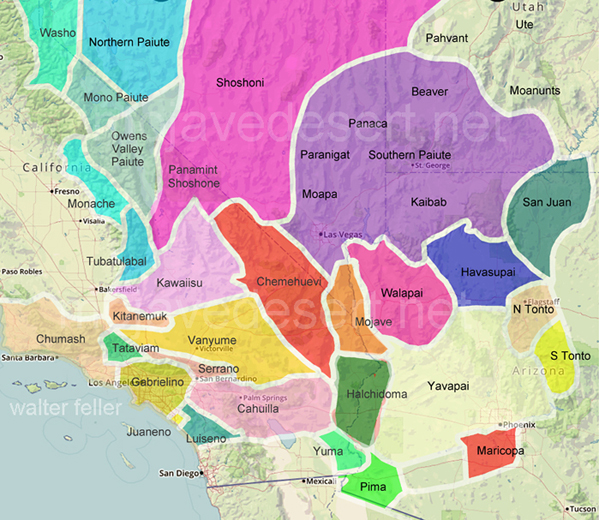
Historic Indian Territories Map
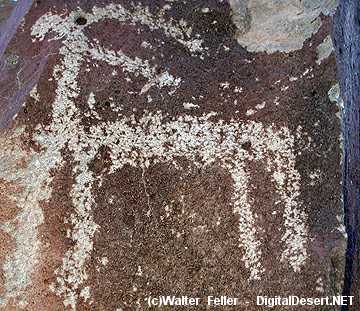
Bighorn sheep are a recurring theme
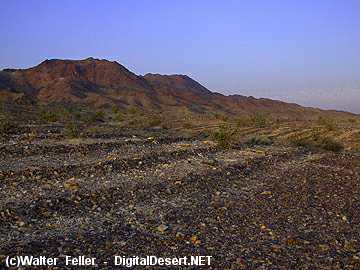
Mohave Maze

Complex design may indicate older cultures
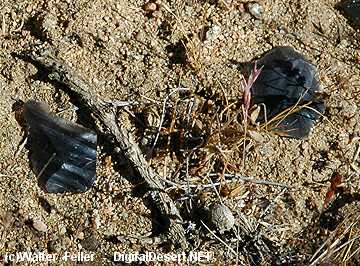
Obsidian flakes from tool making
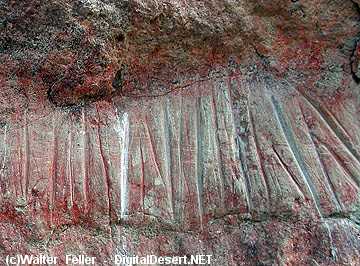
Rock used to sharpen awls used in basket making
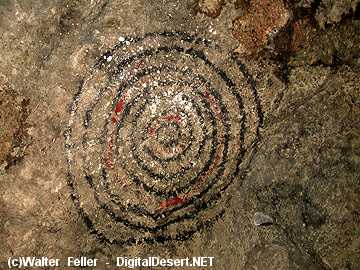
Pictograph
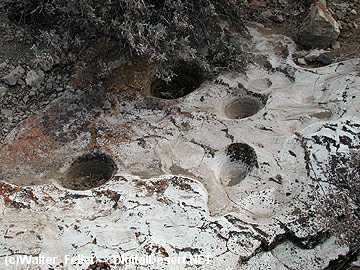
Communal grinding stone